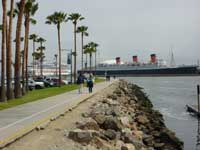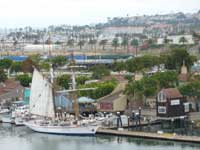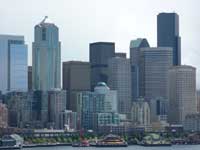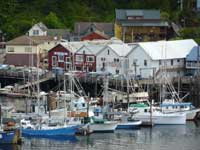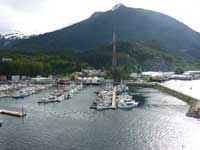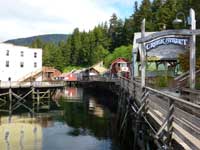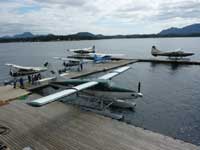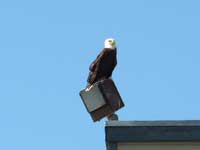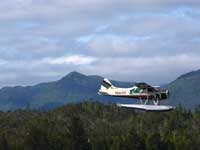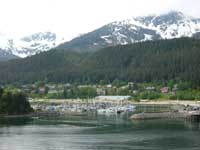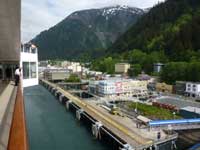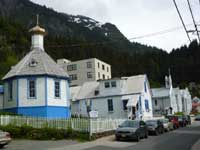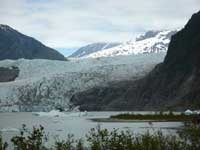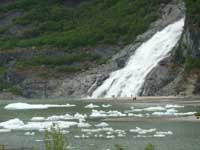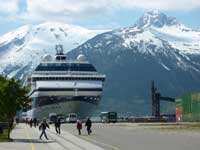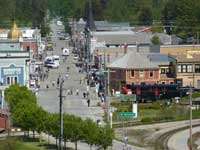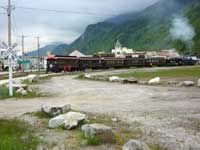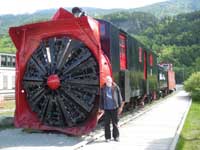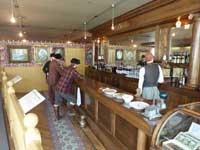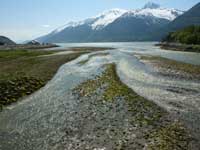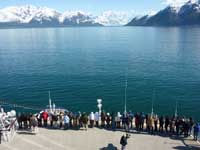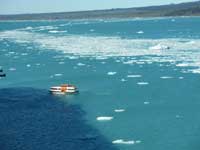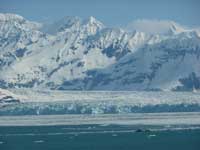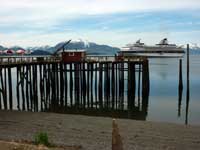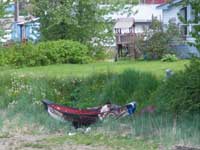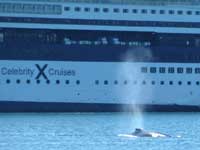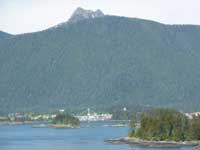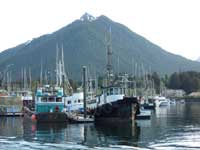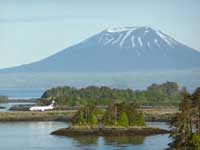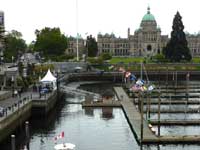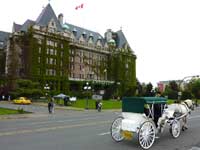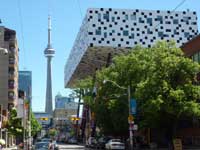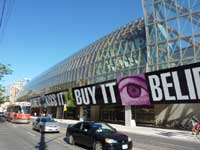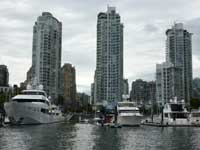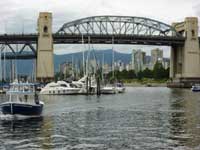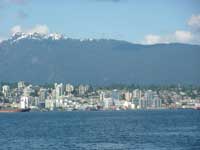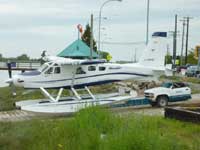Vancouver, Toronto and an Alaska Cruise on Celebrity Mercury in May 2010
Alaska and Canada (download 650KB PDF file) | Map | Cartoon
Alaska and Canada
Los Angeles & Long Beach, California
We arrived in Los Angeles on May 16th after an extremely uncomfortable flight during which even the cabin crew had to remain seated and strapped in due to excessive turbulence. We were fortunate enough to be among the last to be served with dinner and, more welcome, wine, but were also fortunate not to end up wearing it. LA used to be generally considered the worst and unfriendliest airport in the world but we take our hats off to them now as they have obviously taken the criticisms to heart and we enjoyed a remarkably smooth and friendly transit through all the various formalities; the immigration officer even wished Sarah a happy birthday for the 18th.
We had arranged to spend the night at a Holiday Inn in 'downtown' Long
Beach which offered a complementary shuttle bus to the cruise terminal
from whence the cruise would depart next day... or so we thought. With
all the travelling we have done you would have thought we'd learnt to
read our tickets properly by now, wouldn't you? But no: it was only after
a chance remark by the hotel receptionist that we discovered our cruise
line, Celebrity, used a terminal several miles away, almost back to the
airport. No harm done but the expensive taxi ride was our punishment for
being careless!
We did use the shuttle to take us into the town of Long Beach, having
also discovered that 'downtown' does not mean town centre, where we explored
the ocean-front 'village' and had enormous ice creams while we watched
the Goodyear 'blimp' fly overhead. Most fascinating of all, however, was
the human parade. It was the weekend of what must be the biggest Gay Pride
festival in the world and certainly it was very well attended as the queue
for admittance into the main show-ground was never less than a quarter
mile long and grew considerably as the afternoon wore on. We were transfixed
by some of the outfits (or lack of them!) and very overt, extravagant
and outrageous behaviour by a number of attendees of all genders. We knew
that Long beach enjoyed an 'anything goes' attitude but we were surprised
and amused at quite how far it went! It was all very jolly, however, and
everyone was having fun so we just enjoyed the spectacle and laughed along
with everyone else.
After the long flight and change in time zone, we were very tired so had an early dinner and were in bed by just after 9pm. Next morning we spent a couple of hours wandering around the area of the old Queen Mary, which is now a floating hotel in Long Beach and also seeing some more of the town, before we joined the ship, the Celebrity 'Mercury', at the port of San Pedro. After a very smooth and swift embarkation process we found our spacious cabin, which was all we had hoped it might be. We hadn't travelled with Celebrity before but first impressions were certainly excellent ... and were maintained throughout the cruise.
Two days at sea gave us ample time to explore the ship and seek out the best bar, restaurant and coffee shop as well as the shops, library and internet area before we arrived at our first port of call. Before arriving there, however, there was a bit of excitement when a fellow passenger suffered a severe heart attack and the US Coastguard rescue helicopter flew out to the ship from San Francisco, 50 miles away, in order to airlift him to hospital. We were, naturally, concerned for the poor man and even more his wife, who had to remain on board until we reached port but we were, equally naturally, fascinated by the skill and efficiency of the rescue process. Everyone was delighted to hear, a few days later, that the timely rescue had been successful and the gentleman concerned was well on the road to recovery.
And so to ...
Seattle, Washington
This vibrant city combines spectacular natural beauty and cosmopolitan flair as few other places can. Named after the great chief of the Suquamish Indians, Seattle enjoys a unique blend of American, Asian and Native American cultures. Its more recent claim to fame, however, is that it is the home of 'good' coffee - Starbucks et al originated there ... if we were them we'd keep quiet about that as American coffee, in our opinion, is not nearly as good as it thinks it is. Even American visitors to New Zealand admit that ours is better! Poor coffee notwithstanding, and we did succumb to Starbucks several times over the course of our trip, we like Seattle and enjoyed rediscovering the markets and downtown area. We had last been there 25 years ago but it really hadn't changed much at all and the men putting on the display at the fish market are the same ones as those we saw way back then - or more likely their sons as they didn't seem to have aged much!
We were back on board by mid afternoon and on deck as we sailed away towards Alaska and the port of Ketchikan
Ketchikan, Alaska
The ancestral home of the Tlingit (pronounced Klingit) tribe. A major attraction is the world's largest collection of totem poles but as we had been there before, we didn't make the trek again but instead took the funicular railway from Creek Street up to a lodge with a stand of totem poles, representing each of the tribes, in the grounds. Back at sea level, Creek Street, with its original, brightly painted wooden buildings (now mainly souvenir shops) provided an attractive ramble alongside the creek up which salmon swim to spawn (not in May, however). This being early summer the azaleas planted in almost every garden were in full bloom and looked absolutely magnificent in the bright sunshine. This was a real bonus as the last time we were in Alaska, it was in July and we saw nothing but rain and fog the whole time.
So many people have told us that May's the best time so we decided to give it one more chance. We are so glad we did as the weather was perfect all the way and the scenery particularly beautiful as the snow hadn't yet melted off the mountains.
Juneau, Alaska
Alaska's capital city was our next port and here the pioneering spirit lives on in an interesting mix of styles. We picked up a bus map and walking tour guide map and set out to explore the town and the perfectly delightful St. Nicholas Russian Orthodox Church. For over 111 years, the tiny St Nicholas Church has been serving Orthodox Christians in Juneau and the surrounding areas. Its classic onion dome and octagonal shape houses amazing icons and artefacts.
We also walked through the administrative area and saw the State Capitol building but as it was a Sunday we were not able to go in. An amusing aspect of life in Alaska is that when it's warm and sunny, shops and businesses will often close to give the staff a chance to enjoy the unexpected treat of fine weather - we saw a sign on one shop doorway saying it was 'Closed due to sunshine'. We were also amused to spot the Sarah Palin Shop, containing books, photographs and all her campaign paraphernalia, but no customers!
After this we took a bus to the Mendenhall Glacier, pictured here, which is a tongue of ice stretching 12 miles from the Juneau Ice field to Mendenhall Lake. At its widest point, the glacier is more than half a mile wide, with ice 300 to 1,800 feet deep. It was a magnificent sight and we enjoyed the walk on the shores of the lake, getting up close to the little icebergs which that glacier had 'calved'.
By then it was time to return to the ship and prepare to sail for Skagway.
Skagway, Alaska
By embracing its gold-rush past, Skagway has managed to preserve a frontier spirit complete with saloons and dance-halls, though we managed to resist both. One building was covered in antlers but we couldn't work out why - attractive and unusual though it was. We couldn't resist a visit to the Wells Fargo Bank, though, as in spite of being a modern, working bank behind the counter, the main banking hall has been kept as it was in the Gold Rush days, with many of the original artefacts including the original safe, on display. The major attraction of this town, however, is the White Pass & Yukon Railway and a ride on it was a popular trip for many of our fellow passengers. We just looked at the train and also the ice-tunnel borer locomotive which used to be called in to make a way through the winter snow. The train could then travel every day, taking the prospectors to and from their claims.
While we were in Skagway, we had the opportunity to visit an old homestead and this, more than any museum illustrated how hard life was, especially for the women. It was interesting to note that nothing was wasted and even flour sacks were 'recycled' into clothing for the men and children and packing crates made into furniture. This is hardly surprising when one considers the hardship endured in getting themselves and their goods there in the first place.
That evening, as we sailed towards our next destination, we passed some really beautiful, snowy scenery which looked quite other-worldly in the twilight. A lovely small island appeared and on it was a most unusual lighthouse, which you can see in this photograph. We would love to have known the story of how it came to be built.
Hubbard Glacier, Alaska
Hubbard Glacier came next. This was not a port but rather a day of scenic cruising in Yakutat Bay, to gaze upon the magnificent Hubbard Glacier. It is the one glacier in the world that certainly does not move at a 'glacial pace'. In 1986 this, the largest tidewater glacier on continental North America, moved an average of just under 5.5 feet per hour. We did not notice any perceptible movement and nor did it 'calve' while we were there but it was an awe-inspiring sight; we will never tire of the sight, sound and smell of ancient ice and the colours to be seen in it, ranging from brilliant white through shades of green and turquoise, palest blue and the deepest sapphire. Photographs cannot capture the true essence of this natural phenomenon and are always something of a disappointment, but those on the next page may give you an inkling.
Icy Strait Point & Hoonah, Alaska
Fifty miles west of Juneau and at the mouth of Glacier Bay, lies historic Icy Strait Point and the town of Hoonah. Icy Strait Point was originally the centre of the salmon canning industry which has now moved elsewhere. The old cannery and other factory buildings have, however, been turned into an interesting museum, with the old cannery machinery still in situ and models of the canners and fish depicting the processes they went through. A good but somewhat commercial visitor and shopping centre is also featured as well as a meeting hall where displays of Tlingit folklore and dances are performed. We chose to visit the town of Hoonah, which is very much a working fishing town with very few concessions to the tourists who flood off the cruise ships which call at Icy Strait Point, most of whom stay within the confines of the centre - their loss! While we were in Hoonah we enjoyed the beautiful, calm harbour with all the fishing boats and their paraphernalia, spotted numerous birds, including the iconic American bald eagles which abound in Alaska.
A highlight, however, was spotting this otter as it rode the river current through the town and on down to the sea; we felt very privileged to see this delightful creature and were so lucky to just be in the right place at the right time ... with our eyes open.
Back at Icy Strait Point Sarah wanted to have a closer look at cannery museum and Martin went for a walk along to the Point. He was astonished to hear a sudden very loud noise coming from the sea to his left and looked up to see a huge humpbacked whale breaching right in front of him ... what a sight! After watching it and some companions for a while, he went to find Sarah and we both spent a good hour just watching these magnificent creatures perform. Passengers who had booked on the ship's very expensive whale-watching trip could not have been luckier. A different sort of whale was to be seen in some traditional Tlingit carving of a Killer Whale, or Orca, which is also the most commonly spotted whale here in our part of New Zealand.
We also saw lots of porpoises and harbour seals and were very sorry when it came time to leave them and rejoin the ship for our onward passage to Sitka.
Sitka, Alaska
This was, to us, the port-of-call we most wanted to see having enjoyed Michael Chabon's novel, The Yiddish Policemen's Union and become interested in the history of the Russian outpost. (Sitka is, however, not at all like the fictional city in the novel.) A tranquil fishing village, Sitka was once part of the Russian Empire in the time of the Czars. The onion-domed Russian cathedral, much larger than the little chapel in Juneau, was the first place we visited and we were stunned by the quality and sheer quantity of fabulous icons on display.
In spite of fierce fighting and strife in the past Sitka now has a lively and close-knit community that reflects its Tlingit, Russian and American roots and it was possible to trace the history by visiting cemeteries where the various factions were buried. It was all rather sad as none of the graves was well cared for, not even that of a Russian Princess, which is much mentioned as a principal tourist attraction and a matter of some pride to the Russian community. The other notable thing about Sitka was the temperature of 24C which is apparently almost unheard of and all the locals were complaining of heat exhaustion!
This was our last port in Alaska and so we left the United States for Canada and our final port before disembarkation.
Victoria, British Columbia.
The state capital, Victoria is a delightful city and in spite of the icy wind, which cut to the bone (such a contrast with Sitka), we enjoyed walking around and discovering an excellent totem park as well as the bustling waterfront. We had to have a ride on one of the adorable little toy boats which were actually ferries - referred to locally as pickle boats because their colour and shape are reminiscent of pickled gherkins.
It was once a British colony and has retained much of its colonial splendour. The Empress Hotel epitomises the elegance of that era and we just had to treat ourselves to refreshments in the famous tea rooms. Although we eschewed the ruinously expensive Afternoon Tea for which the hotel is famous, we managed very well with a cup of coffee - poured from a silver pot, of course, which warmed us up nicely after our walk in the wind.
Vancouver, British Columbia
The port where we disembarked - but this was only the end of the cruise part of our holiday and we still had a week of visiting friends and family, both here and in Toronto, to look forward to. As we had a few days in each place we were able to see more than in the towns we visited on the cruise as then there is only a day in each port.
We were to stay with our friends Iain and Moya Drummond, from Abu Dhabi days and Iain and son, James, met us off the ship (not without difficulty as the cruise terminal is definitely not arranged with such rendezvous in mind!) and took us to their delightful little house to drop our bags, collect Moya and freshen up. This accomplished, they whisked us off to the Royal Vancouver Yacht Club, of which they are members, and treated us to lunch followed by a tour of the suburbs. This was not their original intention but was necessitated by the demise of Iain's beloved, elderly Porsche the previous evening, which required Iain's presence to attempt a repair and, when that failed, to await the arrival of the AA man. While all that was happening Moya took us to an old industrial area which has now been gentrified and made into a wonderful market selling everything from the enormous spotted prawns, a local delicacy which we enjoyed greatly for dinner that night, to fresh fruit, clothing, hand made greetings cards and jewellery, as well as a truly excellent wine store where we were able to purchase some superb locally produced reds and whites. British Columbian wines are really taking their place among the best of the New World wines and we were very happy to have discovered them.
We like exploring new places by means of public transport whenever possible and Vancouver's comprehensive system of trains, buses and trolley buses as well as ferries, made this very easy and we had a great day covering as much of the city as we could. We visited the Christ Church Cathedral, which was a charming structure with wooden beams and panelling, much like Christchurch Cathedral here in Christchurch, New Zealand. One of the vergers told us that the cathedral had an unusual link with New Zealand as in the last century an organ was being sent to them from Germany but got misrouted to Christchurch, NZ. They finally got it to Canada but it must have been the most widely travelled organ ever built and certainly the most expensive to transport.
Also in the city centre is one of the most intriguing, mesmerising and pointless attractions we have yet encountered on our travels: In the atrium of the Hong Kong & Shanghai Bank there is a giant pendulum. It is made of brushed aluminium, is 27 meters long, 1 meter square and hollow from top to bottom. It weighs 1600 kilos and travels through an arc of about 6 meters. The pendulum movement is assisted by a hydraulic mechanical system at the top. At the end of its swing the 'broken' column comes into alignment with a matching buttress mounted on the Atrium floor. For a moment the two pieces appear as one. Weird but wonderful was our verdict!
Leaving the city centre behind, we took a ferry across to the north shore and caught a bus to Grouse Mountain. We had intended to take the cable car to the summit where we would have lunch overlooking the city and mountains. It was not to be, however, as a heavy mist came down and obscured any view we might have had - it certainly wasn't worth the $40 each for the cable car ride so we stayed on the bus and went back down to the sunny city and had lunch in the market which Moya had taken us to on our first day. We were amused to find ourselves at one point in the journey at the place where we had earlier been to try to rescue 'Portia the Porsche', but have no idea how we got there as the bus route was not at all the same as that taken by Moya!
A train took us to another ferry (reminiscent of the Pickle Boats in Victoria) to Granville Island. From the 1880s, the island was a major hotbed for industrial activity, and sawmilling, iron works and slaughterhouses were commonplace sights. After World War II, however, a series of fires and a changing economy put the island into disrepair. In the 1970s it was rejuvenated and is now a wonderful mix of artists' studios, markets, shops, restaurants, cafes and the most talented buskers we've ever encountered. From there is was time to find our way home, which we did thanks to helpful bus and trolley bus drivers. Moya and Iain were astonished at how much ground we had covered during our day's sightseeing. That night we went to a favourite Malay restaurant and all ate ourselves to a standstill. Luckily it was only a 15 minute walk from home so we were able to walk off some of the excess before retiring for the night.
The following day we were taken out on their lovely boat and went up Indian Creek to Wigwam Inn - the names are so evocative! Wigwam Inn is an 'outstation' of the yacht club. Although there is no restaurant, barbecue facilities are provided and we had a very good lunch of Moya's special home-made burgers with salad, followed by a decadently sticky lemon cake. The memory of the beauty and tranquillity of the setting will remain with us for many years to come.
On the way back, as we approached the busy but attractive Vancouver harbour, we had to make way for a couple of cruise ships, one of which was the 'Diamond Princess', on which you may remember we had sailed in the past; she looked a lot bigger from the deck of Iain's 30 footer than she seemed when we were on board the ship!
On our final day in Vancouver, we had brunch at an hostelry called “The Flying Beaver', where as well as excellent food, we enjoyed watching the sea planes being launched. They were 'parked' in the airport compound and had to be pushed across the road onto the ramp, using the most peculiar Heath-Robinson type sawn-off vehicles we'd ever seen:
It turned out that the driver was also the pilot and it was a nail biting
experience to watch and see if he could park his vehicle back at the airport,
sprint down to the plane and hop in before it floated away!
Moya and Iain then took us to the wonderful Nitobe Memorial Garden. "I
am in Japan," was the reaction of the Emperor of Japan as he walked
through University of British Columbia's renowned Japanese Garden. The
exquisite work of art was created out of two-and-a-half acres of pristine
forest by landscape architects and gardeners recommended by the government
of Japan. Nitobe Memorial Garden is considered to be the one of the most
authentic Japanese gardens in North America and among the top five Japanese
gardens outside of Japan. We were exceptionally fortunate to have Moya
as our guide since she is extremely knowledgeable about the garden and
was chosen to escort the Emperor and Empress of Japan round the garden
during their visit last year. This was a great honour for someone who
is herself not Japanese and we felt honoured to have been given the Imperial
Tour all to ourselves. If you are interested in learning more about this
lovely garden and the philosophy and legends which are incorporated into
it, go to the website at www.nitobe.org.
A few small photos cannot do it justice but these might just give you
a feel for the lush tranquillity to be found in this magnificent, living
work of art, even in the rain which had started to fall.
A short visit to get an overview of the UBC's Botanical Gardens followed but sadly, time was pressing and we had to return to the house for our luggage and the drive to the airport.
Toronto, Ontario
Toronto was also on our itinerary and we actually visited it as a side-trip in the middle of our final week's holiday, Vancouver having been explored on either side of this visit. The trip to Toronto was to catch up with Sarah's cousin, Sue and her husband Andrew, whom we had not seen for over 30 years, having somehow managed never to be in the same country at the same time. The reunion was all we hoped and more and the intervening years just melted away. Although Sue and Sarah sat up late reminiscing and sharing tales of their childhood and mutual grandmother, we did also get to explore the city. Sue made an excellent tour guide, pointing out places of interest to tourists as well as those with particular personal relevance. She also proved to be a very persuasive 'personal shopper' - though in truth Sarah needed very little persuasion to buy a couple of outfits which they spotted in a sale and which clearly called out to her ... it would have been rude to ignore them!
A highlight of our visit was the Art Gallery of Ontario (AGO) which is not only a stupendous building with the most incredible staircase but also houses a fabulous collection of amazing artworks. A large collection of Henry Moore sculptures and Sarah's favourite Barbara Hepworth sculpture, Mother and Child, were particularly exciting, as was the installation in the long gallery featuring trees within trees.
As Sue had a meeting to attend the following day and Andrew had to work, we armed ourselves with a public transport map, a day ticket and lots of advice from our hosts, and spent the morning riding and walking around the city. We explored the old Distillery area which has now been turned into artisans' workshops, art galleries, unusual shops and cafes, many of the buildings with the original machinery still on display, as well as sculptures reflecting the origins of the area in the open spaces.
Unfortunately a lot of the places were closed in preparation for a private, VIP visit the next day. However, we saw enough to give us a feel for the place and had an excellent coffee in an old French-style café with a wonderful silver urn in pride of place and a small but fascinating art gallery upstairs.
A mixture of buses and trams gave us access to the waterfront area and also the various 'towns' which make up Toronto: China, Korea and Greece are all represented as well as many other ethnicities. Toronto abounds in squares and parks and these open spaces turn this huge city into one of much more human and manageable proportions. The natives have a quirky sense of humour and we were amused by pubs and cafes called 'The Village Idiot', 'Sin & Redemption' and 'Nervosa'. With such diversity, good food was easy to find and one could easily be spoiled for choice. Sue had taken us to a restaurant called 'The Pickle Barrel' the previous day and we enjoyed it so much that we decided to eat there again and arranged to meet Sue there for lunch. It was as good the second time around but the portions so large that we took home enough for at least one more lunch, which we hope Sue and Andrew enjoyed after we had gone. In the evening we went to a Greek restaurant near their home and had a superb and truly memorable meal - again eating ourselves to a standstill. Sadly, this was our 'last supper' as we were to leave the next day. Just before we left, Sue presented us with a beautiful album, a Memory Book, which she had started to prepare before we arrived and had sat up late every night, adding pictures and words to remind us of each day's experiences; something to treasure always.
We have reflected upon our three week trip and wondered what had made it so special, meaningful and memorable, apart, of course, from the reunion with Sue and Andrew, Moya and Iain. We realised that it was because Alaska and Canada have much in common with New Zealand. The history of immigration from Europe and China and the traditions of the early settlers and Inuit, or First Nation, peoples are very similar to the pattern of immigration to New Zealand and the folklore of the Polynesian and Maori people. Indeed, much of the traditional carving of personal adornments, particularly of bone and greenstone, was indistinguishable from that which we see here. Traditional drawings and sculptures are also stylistically very similar. The Pacific Ocean is vast, indeed, but it cannot be coincidence that peoples from the far northwest and equally far southeast of this great ocean have so much in common.
The journey home was far smoother than the outward flight and we arrived in Auckland in good time to catch our onward flight to Kaitaia where Sallie was awaiting us - the best 'welcome home' anyone could wish for.
Alaska and Canada (download 650KB PDF file) | Map | Cartoon

